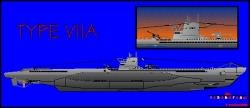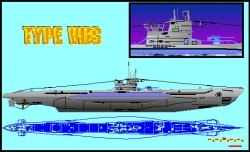| Type VIIA to VII C U-boat From U-boat Net |
||||
|
The Type A, designed in 1933-1934, were the first of a new generation of German attack U-boats known as Type VII. Ten of these were built between 1935-37. The Type A were popular with their crews and very agile on the surface. They also had a much more powerful striking power than the smaller Type II's. They had 5 torpedo tubes (4 at the bow) and would carry 11 torpedoes onboard or 22 TMA (=33 TMB) mines. They also had the effective 88mm fast-firing deck gun with about 160 rounds of ammunition.
Type VIIB was an improvement on this design with substantially increased range. All but two (U-29 and U-30, both scuttled in Kupfermühlen Bay on May 4, 1945) Type VIIA U-boats were sunk during World War Two. Soon it was discovered that the only real drawback of the VIIA was the small fuel storage for the role intended. This was mostly fixed in the VIIB which had additional 33 tons of fuel in external saddle tanks which gave them additional range of about 2500nm at 10 knots. They were also considerably more powerful and slightly faster than the VIIA was. These boats (and all following the design) had two rudders instead of the one found on the VIIA, allowing them even more agility. 24 were built from 1936-1940. These boats had the same armament as the VIIA, 4 bow torpedo tubes and one tube at the stern. U-83 was the only type VIIB without the stern torpedo tube. The only major armament difference was that 3 additional torpedoes could be stored for a total of 14. The next development of these series was the mass produced type VIIC with several improvements. Type VIIB included many of the most famous U-boats during World War 2, including Kretschmer's U-99, U-48 which was the most successful U-boat, Prien's U-47 and Schepke's U-100. |
Type VIIC was a slightly modified version of the successful VIIB. They had basically the same engine layout and power, but were slightly larger and heavier which made them not quite as fast as the VIIB. 5 torpedo tubes (4 at the bow and one at the stern) were installed in all but the following boats; only two bow tubes (U-72, U-78, U-80, U-554 and U-555) and no stern tube (U-203, U-331, U-351, U-401, U-431 and U-651). The VIIC was the workhorse of the German U-boat force in World War Two from 1941 onwards and boats of this type were being built throughout the war. The first VIIC boat being commissioned was the U-69 in 1940. The VIIC was an effective fighting machine and was seen in almost all areas where the U-boat force operated although their range was not as great as the one of the larger IX types.
The VIIC came into service as the "Happy Days" were almost over and it was this boat that faced the final defeat to the Allied anti-submarine campaign in late 1943 and 1944. Perhaps the most famous VIIC boat was the U-96 which is featured in the movie Das boot, other noticeable boats were the U-flak boats. Many of these boats were fitted with the Schnorkel in 1944-1945. This design saw one more improvement in the type VIIC/41. The larger mine-laying type VIID was a direct variant of the VIIC. The Type VIIF boats, designed in 1941, were primarily built as torpedo transports and were never fitted with the typical 88mm deck guns found on other VII type boats. They had 5 torpedo tubes (4 at the bow and 1 at the stern) and as attack boats they would carry 14 torpedoes but in their transport role they would have up to 39 torpedoes onboard. Two of them, U-1062 and U-1059, were sent to support the Monsun boats in the far East waters. They were the largest and heaviest type VII boats built. Go to The Elektro Boats
|
|||
|
© 1997 - 2000 COMBATSIM.COM, INC. All Rights Reserved. Last Updated February 5th, 1999 |
||||



